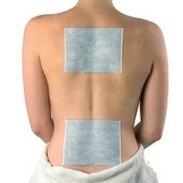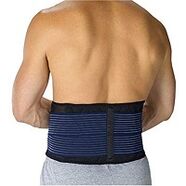
Back pain is a very common phenomenon, it is difficult to find a person who does not face this problem.
Also characteristic is the perennial problem of "lack of time" to go to the doctor, whereby most people prefer self-medication, for which they use well-advertised gels and ointments that eliminate back pain.
Along with these means, plasters are actively advertised. This remedy for back treatment has been known for a long time, but in recent years it has not enjoyed much popularity until major manufacturers have adopted it.
To understand if these patches are really effective, one must understand the possible causes of back pain.
why does my back hurt?
Back pain can have many causes. The most harmless of these are minor injuries and sprains that a person can have during sports and physical work.
Although, in the absence of proper attention to such minor injuries, they can have very unpleasant "delayed" consequences, affecting the condition of the muscular back corset and the musculoskeletal system itself.
<2_img_rightxx>But in the general case, these minor injuries remind themselves with pain for several days, after which they gradually disappear.
But the most common cause of back pain is osteochondrosis and its consequences.
This disease is dangerous because it develops gradually and in the early stages, when it can still be successfully treated, it does not manifest itself with any practical symptoms.
In the future, it is this disease that becomes the cause of the development of various pain syndromes, the formation of intervertebral hernias, and so on.
If micro-traumas to the back can still be ignored while waiting for the moment to stop causing pain, then it won't work for osteochondrosis - when its consequences manifest themselves, you won't be able to withstand severe pain for long and will still have to go. to the doctor.
Furthermore, if minor injuries are successfully eliminated by improvised means, severe back ailments must be treated for years.
The main cause of pain in this disease is the violation of the nerve roots of the spinal cord. This compression can occur for a variety of reasons, but it is this compression that causes almost all pain syndromes.
Warming effect in the treatment of back pain

When treating back injuries or illnesses, doctors often recommend "dry heat" along with necessary medications.
This usually means wrapping the affected part of the body with a warm, fluffy handkerchief - so that the back of the affected area is very "warm".
This "dry heat" improves blood circulation, whereby inflammation and edema decrease to some extent, which leads to a decrease in pressure on the compressed nerve root.
Consequently, the pain syndrome diminishes. Of course, this method alone does not deal with severe pain, but it is quite suitable as an auxiliary means.
Furthermore, it is noted that the overwhelming majority of folk recipes for back pain are based precisely on this warming effect on the affected region of the back. And with not very intense pain, such methods deal successfully, although they don't allow you to get rid of the cause of its occurrence.
Warming as an alternative to tablets
When back pain occurs, doctors tend to prefer medications. And these methods, in most cases, involve the use of nonsteroidal anti-inflammatory drugs, which quickly relieve inflammation and reduce pain.
Therefore, NSAIDs primarily pursue one goal - to reduce the pain, which in most cases they are able to deal with.
But these drugs have a serious downside - treating back disease involves a very long use of them, in which case side effects start to show up.
The most common of these effects is the disturbance of the gastrointestinal tract. So, for example, the treatment of a herniated disc can take up to a year, and taking NSAIDs without significant consequences for the patient's body can rarely last longer than a month.
This leads to the fact that physicians are obliged to prescribe such drugs at the lowest effective doses and to look for alternative methods of treatment.
First, they pay attention to gels and ointments, which are found in large quantities in pharmacies.
But half of them, in this case, are not suitable, since their entire effect is based on the action of all the same NSAIDs. Ointments of a "hot" nature are much more expensive and less common.
Another popular alternative now is the cast, which is invisible, securely attached to the back and relieves back pain quite effectively.
Types of Back Patches
pepper plaster
The oldest and most "deserved" is the banal pepper plaster, which has been known for a long time. The principle of action is simple and clear - a special pepper composition is applied to the sticky surface, which has an irritating and warming effect when touching the skin.
Perhaps the only disadvantage of this adhesive is the excessive aggressiveness of the pepper, which, at the slightest violation of the rules for using the adhesive, can cause serious irritation to the skin.
And this will severely limit the possibilities for treatment - the inflamed area cannot be massaged, it is no longer possible to glue on another plaster or apply a warming gel or ointment.
These deficiencies have become the reason for the search for alternative heating compositions that will be applied to the adhesive with no less efficiency.
Anesthetize without heating - NSAID adhesive
Several manufacturers, without further ado, decided to work around the problem of skin irritation in a simple and graceful way - the same non-steroidal anti-inflammatory drugs are simply applied in the patch, which are gradually absorbed by the skin and have their therapeutic effect.
Thanks to this patch, back pain is quickly removed, the risk of irritation is minimal and the problem of overheating is not worth it either. But this patch also has drawbacks.
For example, they are definitely not suitable for those who prefer to do without "chemistry" if possible, as the main active ingredient is the same as the pills, it just enters the body through the skin, having all the same unpleasant side effects.
reflected heat
Another option is plasters, which contain one or another "reflective" coating. It's not as important as the manufacturer specifically called it, the essence is the same - the heat released by the human body is reflected and accumulated, from which a warming effect arises.
Of course, these plasters have practically no contraindications (since there is no active ingredient), but it is better to stick them not on the skin but on the linen.
China's "Miracle Thoughts"
Various types of patches have been developed in China based on local traditional medicine. The composition of such a patch contains many plant components, each of which (in theory) should have a certain therapeutic effect.
This patch is a very good choice for lovers of "natural" treatment, its only downside is its unconfirmed effectiveness.



































